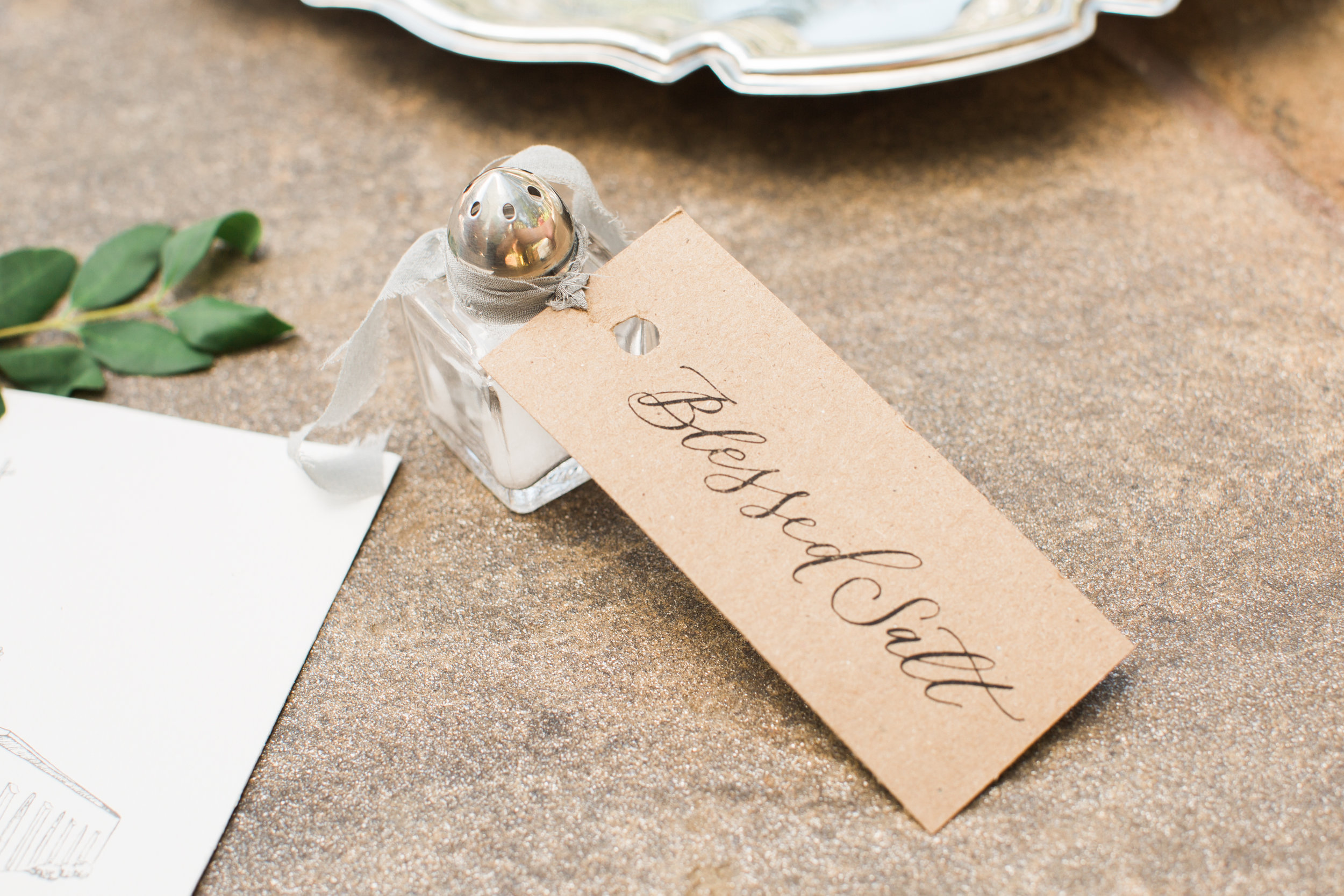Catholic Wedding Ceremony
Betrothal or Rite of Betrothal | An ceremony held during engagement, in which a couple makes a binding commitment to marry. The Rite of Betrothal is an ancient tradition of the Church that has had a resurgence in the 21st century. It is optional, but beautiful, and can be as simple or elaborate an event as you desire.
Learn about the Rite of Betrothal here, and see Danielle + Jeff’s betrothal ceremony here.
Consent | The bride and groom profess their consent to one another through the saying of the vows. The consent must be completely a completely free act of the individual’s will.
Celebrant / Concelebrant | The priest (or priests) present on the altar at a Catholic wedding ceremony stand as witness to the Sacrament as the celebrant. Their blessing of the marriage is a necessary component to make the marriage valid.
Confer | The bride and groom are the ministers of the sacrament of matrimony; as they express their mutual consent, they confer the sacrament and grace upon each other with the priests and guests as witnesses to their consent.
Covenant | Through the sacrament of marriage, a bride and groom are brought together in an unbreakable union as an image of the union of Christ and his bride, the Church. The nature of his union is covenantal.
Consummate | Catholic theology is made visible through sacramental signs. In the Sacrament of Marriage, the truth of the spoken vows is made visible and complete when the marriage is consummated through the physical intimacy between the bride and groom.
Receiving Line | This custom occurs at the back of the church when the newlyweds greet wedding guests as they depart from the ceremony. This can take a long time and isn't very common anymore; many couples make a point to speak with everyone at the reception.
Venues, Food, and Beverages
PP+ | An abbreviation for per person. If a caterer quotes you $50pp+, for instance, it means $50 per person. The plus sign indicates plus service charge (usually 18-28%), then sales tax.
Service Charge | Typically if a service charge is included, it is not necessary to tip the staff.
Pro tip: Note the customs of the region you are getting married. In the north, it’s customary to tip every single person involved in your wedding. In the south, it is not customary to tip anyone unless they go above and beyond in their job.
BEO (or Banquet Event Order) | This is a phrase used by caterers to summarize the quote for all notes and details of the wedding day.
F&B (Food and Beverage) Minimum | If a venue has the ability to host and cater your event, they may inform you of a F&B minimum. This is the minimum amount of food and beverage that must be--or money spent--as part of the event contract. If your menu does not equal or surpass the minimum, you may have to pay the difference as a rental fee.
Pro tip: Unless noted, the F&B minimum does not include sales tax, service charge or alcohol tax; these are all charged in addition to the minimum.
Reception
Cocktail hour | Occurs prior to the reception at the reception venue. Generally, this hour provides the newlyweds, family and wedding party time to complete photographs.
Budget tip: Cut the cocktail hour to save on additional food and drink costs.
Escort Cards | Often presented as cards, written on a mirror or printed on a board outside of the seating area, the “escort cards” inform wedding guests what table they are assigned to. This is a tool to create order as guests transition to the reception. Planning seating arrangements requires more time and effort in wedding planning, but provides structure and organization for guests.
Budget tip: Group families or couples together, rather than one card per person, to save on materials and time.
Place Cards | These small cards assign each guests to a specific seat at their table. The only time this is necessary is when guests choose their entree before the wedding (if the option is available on their RSVP card). The place cards are used to communicate with the catering staff for effective meal service.
Introductions | The band or DJ can announce and introduce the bridal party and the bride and groom for the first time! Specific music, dance moves, or accessories can be incorporated to show off the personality of the entire bridal party.
Pro tip: This time offers a chance for the bride and groom to transition directly from their introduction into their first dance. You already have everyone’s attention and it eliminates an interruption later in the evening!
Blessing | Consider if you will include a blessing of the meal and, if so, who will offer the blessing at your reception. This person--whether a priest, friend, or family member--should be prepared beforehand.
Special Dances | Beyond the bride and groom’s first dance, other special dances include the mother-son and father-daughter dance, an anniversary dance, sorority or fraternity dance, etc. It is important that these plans--including the timing and song requests--are clearly communicated with the band or DJ prior to the wedding day.
Bouquet Toss and Garter Toss | These experiences are often seen as long-standing wedding traditions, buy are not necessary. If you don’t want to draw attention to single wedding guests, or if this elicits an uncomfortable environment for you (or your wedding guests), simply omit this tradition or replace it with another creative tradition, such as a special dance. Whether you decide to include the bouquet or garter toss or not, the plan needs to be communicated to your emcee or DJ.
Cake Cutting | Beyond cutting the wedding cake, this moment typically includes toasts from parents, the best man, and the maid or matron of honor.
Pro tip: Beginning the toasts and cutting-of-the-cake while guests finish dinner is an efficient way to capture the attention of wedding guests while they are all still in the room and provides more time to bust a move on the dance floor later!
Send Off | The moment the wedding guests bid farewell to the bride and groom. Sparklers, confetti poppers, and bubbles are some of the common tools for a send off into their “happily ever after.”
Pro tip: At the end of the reception, the send off is a great way to signal to guests that it is time to leave. This helps eliminate overtime fees at venues and with vendors who are paid by the hour.
Rain Plan (or Plan B) | If the reception is an outdoor venue, a rain plan is absolutely necessary! Some venues may require a deposit if you want to include an outdoor tent as part of your rain plan, while other venues have an indoor option available. The peace of mind for the secondary plan may be worth every penny.
Belly bar | This is a high-top table generally used during a cocktail hour or around the periphery of the reception venue for guests to watch the dance floor or mingle away from the crowds.
What words did you learn in the process of wedding planning? Or what what words have your heard that you don’t understand? Share your knowledge with and bring your questions to Spoken Bride’s community of brides-to-be on Facebook and Instagram.





































